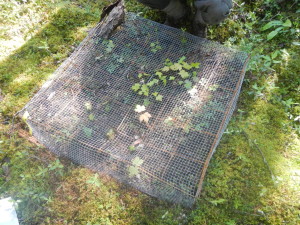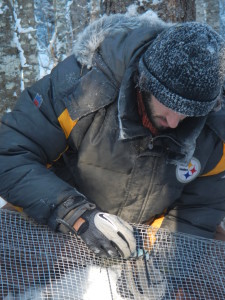The ability of tree species to track their climatic niche at rates comparable to global warming is of concern, particularly if they are constrained by local adaptation. If a species is locally adapted at its range margin, it could be beneficial for range expansion because it ensures that the genotypes colonizing new areas are the fittest,
given that environmental conditions are more similar to the current ones. In trees, local adaptation can slow range expansion when climate change happens much faster than their ability to migrate.
We investigate experimentally a series of factors thought to constrain the seedling phase at the leading edge of the distribution of a dominant tree species, sugar maple (Acer saccharum Marshall.). We established a seed transplant experiment using six provenances, representing the latitudinal species range, and transplanted them to 12 sites within, at and beyond the current northern species range margin. Results: At present, northern provenances provide the best opportunity for establishment beyond the current range, where climatic conditions are more similar than those of the warmer central or southern portions of the species range. Establishment
was highest within the species range, but survival rates were comparable to those at the range margin and beyond, regardless of provenance. We also found that the local climate was the most influential factor for early seedling establishment and survival;
however, a lack of suitable microsites also significantly constrained recruitment. Main conclusions: Our study highlights the complex interaction between provenance, climate and microsite conditions that is required to ensure successful seedling recruitment. Although sugar maple is currently displaying evidence for local adaptation
to facilitate range shifts, it could risk maladaptation in the future if the local climate warms beyond a threshold required to ensure seed germination and a lack of favourable microsite conditions beyond the range.
Questions
Which is more influential for early establishment of sugar maple: climate or microsite?
Which provenances are best adapted to warmer temperatures and boreal microsites?
Predictions
Germination and survival of northern provenances will be: (a) highest at the current northern range limit, whereas the opposite will be observed for southern provenances.
Germination and survival will be the highest at microsites occurring beyond the current range (corresponding to cold and acidic soil conditions with a thick needle cover), whereas the opposite will be observed for southern provenances.
Experimental Design:
We set up a fully randomized factorial design where we crossed climatic conditions, biotic environment and provenance. We did this by collecting seeds from six provenances representing the entire species range and seeded them to four sites located within the species limit, four sites at the northern range limit and four sites beyond the current species northern range limit. This experimental design allowed us to investigate local adaptation of early seedling stages, while also making inferences regarding the potential barriers for seedling establishment in new environments.
Interested in finding out more. This study was published in the journal of Global Ecology and Biogeography. Click (Here) to view the publication.
In addition the data are also available. Please click this (Link) to access the data.


